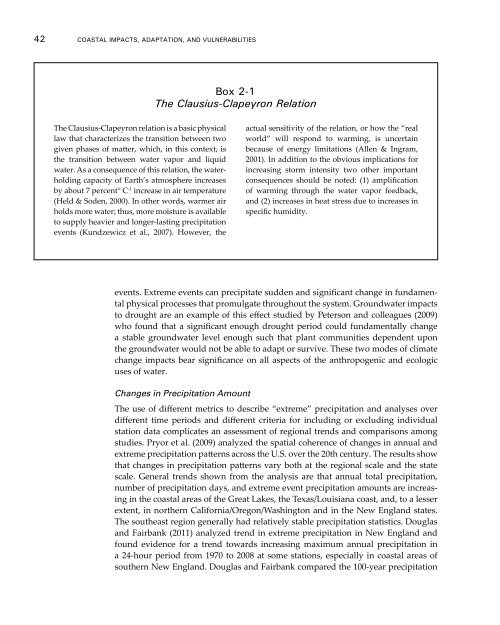Coastal Impacts, Adaptation, and Vulnerabilities - Climate ...
Coastal Impacts, Adaptation, and Vulnerabilities - Climate ...
Coastal Impacts, Adaptation, and Vulnerabilities - Climate ...
You also want an ePaper? Increase the reach of your titles
YUMPU automatically turns print PDFs into web optimized ePapers that Google loves.
42 <strong>Coastal</strong> <strong>Impacts</strong>, <strong>Adaptation</strong>, <strong>and</strong> <strong>Vulnerabilities</strong>Box 2-1The Clausius-Clapeyron RelationThe Clausius-Clapeyron relation is a basic physicallaw that characterizes the transition between twogiven phases of matter, which, in this context, isthe transition between water vapor <strong>and</strong> liquidwater. As a consequence of this relation, the waterholdingcapacity of Earth’s atmosphere increasesby about 7 percent° C -1 increase in air temperature(Held & Soden, 2000). In other words, warmer airholds more water; thus, more moisture is availableto supply heavier <strong>and</strong> longer-lasting precipitationevents (Kundzewicz et al., 2007). However, theactual sensitivity of the relation, or how the “realworld” will respond to warming, is uncertainbecause of energy limitations (Allen & Ingram,2001). In addition to the obvious implications forincreasing storm intensity two other importantconsequences should be noted: (1) amplificationof warming through the water vapor feedback,<strong>and</strong> (2) increases in heat stress due to increases inspecific humidity.events. Extreme events can precipitate sudden <strong>and</strong> significant change in fundamentalphysical processes that promulgate throughout the system. Groundwater impactsto drought are an example of this effect studied by Peterson <strong>and</strong> colleagues (2009)who found that a significant enough drought period could fundamentally changea stable groundwater level enough such that plant communities dependent uponthe groundwater would not be able to adapt or survive. These two modes of climatechange impacts bear significance on all aspects of the anthropogenic <strong>and</strong> ecologicuses of water.Changes in Precipitation AmountThe use of different metrics to describe “extreme” precipitation <strong>and</strong> analyses overdifferent time periods <strong>and</strong> different criteria for including or excluding individualstation data complicates an assessment of regional trends <strong>and</strong> comparisons amongstudies. Pryor et al. (2009) analyzed the spatial coherence of changes in annual <strong>and</strong>extreme precipitation patterns across the U.S. over the 20th century. The results showthat changes in precipitation patterns vary both at the regional scale <strong>and</strong> the statescale. General trends shown from the analysis are that annual total precipitation,number of precipitation days, <strong>and</strong> extreme event precipitation amounts are increasingin the coastal areas of the Great Lakes, the Texas/Louisiana coast, <strong>and</strong>, to a lesserextent, in northern California/Oregon/Washington <strong>and</strong> in the New Engl<strong>and</strong> states.The southeast region generally had relatively stable precipitation statistics. Douglas<strong>and</strong> Fairbank (2011) analyzed trend in extreme precipitation in New Engl<strong>and</strong> <strong>and</strong>found evidence for a trend towards increasing maximum annual precipitation ina 24-hour period from 1970 to 2008 at some stations, especially in coastal areas ofsouthern New Engl<strong>and</strong>. Douglas <strong>and</strong> Fairbank compared the 100-year precipitation
















